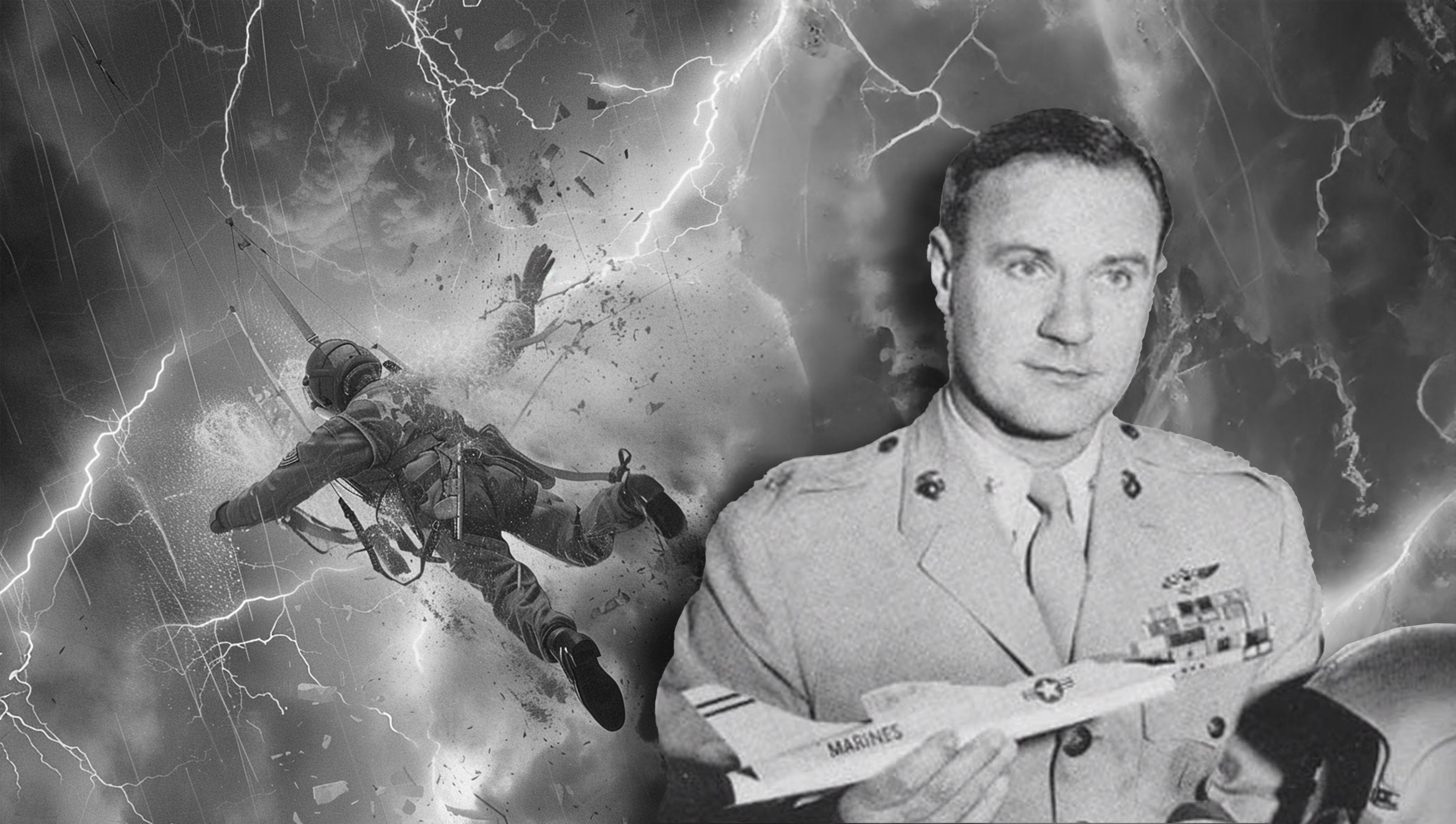William Rankin: The Man Who Fell Through a Cloud
NEW EPISODE! When he was forced to eject from his F-8 Crusader in 1959, Lt. Col. William Rankin found himself falling through a thunderstorm. To this day, he’s only one of two people to survive a fall through a cumulonimbus thunderstorm. In this episode, we tell the story of Rankin’s harrowing ordeal and then play the quiz game with Comedian Lisa Berry!

We’ve told some incredible stories of survival on this show. The story of Juliane Koepcke was one that comes to mind. That was the teenager who fell from the sky and lived a couple weeks in the jungles of Peru. This is a somewhat similar story in that its about a man who fell from the sky. Let’s meet Lt. Col. William Rankin.
William Henry Rankin was born in 1920. He joined the military after school and fought in World War II and the Korean War as a Marine Pilot. By the 1950s, he had reached the rank of Lieutenant Colonel and was flying F-8U Crusaders off of aircraft carriers during the Cold War effort as the Commander of VMF-122, a Marine Fighter Attack Squadron. His home base was in Beaufort, South Carolina and Rankin along with Lt. Herbert Nolan were traveling from Naval Air Station South Weymouth, Massachusetts back to their base in Beaufort, South Carolina. They were flying their two F8-U Crusaders and were somewhere over Virginia when disaster struck.
If you’re unfamiliar with the F-8U aircraft, this is a supersonic single-engine jet aircraft designed to operate from aircraft carriers. It was developed in 1952 and had a relatively short production life – the last one was manufactured in 1964. It’s often referred to as “the last of the gunfighters” because as aircraft were being designed with their primary weapons as missiles and bombs, the F-8U’s primary weapon was the 20mm cannon, which is a huge round – not as big as the A-10 Thunderbolt’s 30mm rounds, but they wanted this aircraft to have something larger than the 50 caliber guns that had proven insufficient during the Korean War. It was also a super fast aircraft – it was the first American jet fighter to reach 1,000 miles per hour. It had a variable incidence wing, which is a system to change the angle of the wings – that’s different than sweep wings, but it also had the ability to fold the wings up at the end, which helped to make more space on-board the carriers. It was equipped with a ram air turbine, which was a common backup system. Basically, if the engine stopped while the aircraft was in motion in the air, the ram air turbine could use incoming air to restart the engine. This will be important to remember in William Rankin’s case. The F-8U had a ceiling of about 52,000 feet, and was often used for reconnaissance and spy missions.
It was a difficult plane to fly, and the technology was fairly new. In 1959 alone, 32 F-8U crusaders crashed. Now fortunately, only 3 of those crashes ended in pilot fatalities, but it was July 26th and 14 of these crashes had already occurred.
But for Rankin, this was just a flight home to South Carolina from Massachusetts. He and his flight partner were flying under the call sign Tiger Two and were expecting the trip to take around 70 minutes to span the 800 miles. It was a pretty routine flight and the two were just wearing light summer flight suits. As they were in the area over Norfolk, Virginia, they approached a huge thunderstorm, with thunder clouds extending up to 44,000 feet.
To avoid the storm, the pair ascended to 48,000 feet. And that’s when Lt. Col. Rankin heard a thump and then grinding noises coming from the jet’s single engine. Then another thump and a warning light in the cockpit before he heard the engine seize up and cut out completely. As I mentioned earlier, there is a failsafe in place for this type of emergency. But as Rankin pulled the lever to deploy the backup ram air turbine system, the lever broke off in his hand. He had run out of options. At 47,000 feet, and still traveling hundreds of miles per hour, he pulled the lever to eject from the aircraft. It was around 6pm in the evening. When Lt. Herbert Nolan looked out the window of his jet, he saw Lt. Col. Rankin spinning wildly with all his limbs outstretched before he disappeared into the thunderstorm below.
Ejecting from a jet fighter is never routine. But through the years, engineers have developed all kinds of ways to make it survivable. In the case of the F-8U-1, the early variant that Lt. Col. William Rankin was flying, it was equipped with a Vought Ejection seat. When he pulled the ejection lever at 6pm on July 26th, 1959, the seat operated as expected. But that wasn’t the problem.
The problem was that he was at 47,000 feet. Humans don’t have enough oxygen to breathe above around 26,000 feet and the ambient static pressure is only about 13% of the air pressure that we experience at ground level. To put it simply, it’s basically unsurvivable to remain at that altitude wearing nothing but a thin flight suit and no pressure suit. Rankin was falling quickly and was instantly hit with rapid onset frostbite to his extremities. His abdomen swelled several times its normal size and he began bleeding from his eyes, ears, nose and mouth.
The temperature change William Rankin experienced was going from 75 degrees Fahrenheit inside the cockpit to an instant -70 degrees Fahrenheit in the sky. The spin that he fell into pulled his limbs outward and the centrifugal force from spinning was too strong to even move his arms or legs. His oxygen mask had been knocked free from his face, so his first order of business was trying to get that back to his mouth and nose to breath from his bail-out oxygen tank. He fell into the storm cloud below and his spinning slowed down enough to reach the oxygen mask, which was the only thing that kept him from experiencing brain-death from lack of oxygen.
He was free falling into the violent storm, but still alive. The next test would be for him to deploy his chute. The chute deployment worked on barometric pressure and would automatically deploy when Rankin hit 10,000 feet. But he was in a giant cumulonimbus cloud. The barometric pressure was all messed up. So at somewhere between 15 and 20,000 feet, the parachute deployed prematurely. It was good that the chute expanded above him and slowed his descent, but the fact that he was still so high in the air meant that he was subject to the violent storm conditions and winds inside the cloud. And the movement was violent. Instead of falling, the parachute suddenly carried him upward thousands of feet.
Rankin’s body had been through so much already, and now he found himself vomiting from all of the trauma. He was being violently pelted by baseball-sized hailstones at one point and at another the rain was so thick, he found himself needing to hold his breath just in order to keep from drowning. Lightning began surrounding him. The bolts appeared as bright blue columns of light several feet in diameter. The accompanying thunder shook his body to the core. One lightning bolt was so close, he thought he had been struck and had died.
Finally, Rankin could see the dark ground approaching below him and landed in the forest in North Carolina. He didn’t know it yet, but he had landed in Ahoskie, North Carolina, more than 65 miles from Norfolk, Virginia where he had bailed out. His aircraft crashed in Scotland Neck, North Carolina, 30 miles from where he landed. Bruised, badly frostbitten and covered in welts from hail, Lt. Col. Rankin looked at his watch. It was 6:40pm. In clear conditions, he would have landed somewhere around 5 minutes after he ejected. Rankin had been falling for 40 minutes from the time he ejected.
William Rankin made a full recovery from his harrowing ordeal and went on to continue to have a successful aviation career. He died in 2009 at the age of 89. His story was written in an autobiography he penned in 1960 called “The Man Who Rode the Thunder.” To this day, he’s only one of two people to survive falling through a cumulonimbus thunder cloud. The internet says it’s true.

Review this podcast at https://podcasts.apple.com/us/podcast/the-internet-says-it-s-true/id1530853589
Bonus episodes and content available at http://Patreon.com/MichaelKent
For special discounts and links to our sponsors, visit http://theinternetsaysitstrue.com/deals

